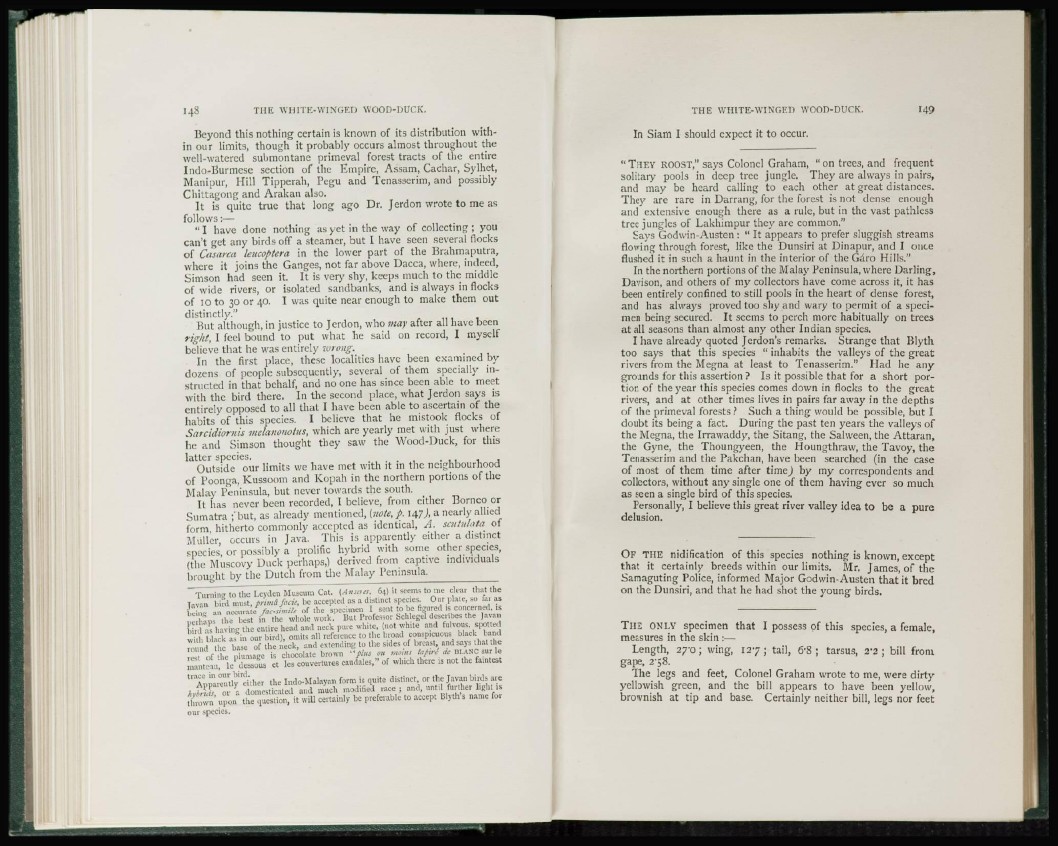
148 THE WHITE-WINGED WOOD-DUCK.
Beyond this nothing certain is known of its distribution within
our limits, though it probably occurs almost throughout the
well-watered submontane primeval forest tracts of the entire
Indo-Burmese section of the Empire, Assam, Cachar, Sylhet,
Manipur, Hill Tipperah, Pegu and Tenasserim, and possibly
Chittagong and Arakan also.
It is quite true that long ago Dr. Jerdon wrote to me as
follows:—
" I have done nothing as yet in the way of collecting ; you
can't get any birds off a steamer, but I have seen several flocks
of Casarca leucoftera in the lower part of the Brahmaputra,
where it joins the Ganges, not far above Dacca, where, indeed,
Simson had seen it. It is very shy, keeps much to the middle
of wide rivers, or isolated sandbanks, and is always in flocks
of 10 to 30 or 40. I was quite near enough to make them out
distinctly."
But although, in justice to Jerdon, who may after all have been
right, I feel bound to put what he said on record, I myself
believe that he was entirely wrong.
In the first place, these localities have been examined by
dozens of people subsequently, several of them specially instructed
in that behalf, and no one has since been able to meet
with the bird there. In the second place, what Jerdon says is
entirely opposed to all that I have been able to ascertain of the
habits of this species. I believe that he mistook flocks of
Sarcidiotuis melanonoius, which are yearly met with just where
he and Simson thought they saw the Wood-Duck, for this
latter species.
Outside our limits we have met with it in the neighbourhood
of Poonga, Kussoom and Kopah in the northern portions of the
Malay Peninsula, but never towards the south.
It lias never been recorded, I believe, from either Borneo or
Sumatra ;'but, as already mentioned, [note,p. 14.7), a nearly allied
form, hitherto commonly accepted as identical, A . scutulata of
Miiller, occurs in Java. This is apparently either a distinct
species, or possibly a prolific hybrid with some other species,
(the Muscovy Duck perhaps,) derived from captive individuals
brought by the Dutch from the Malay Peninsula.
Turning to the Lcyden Museum Cat. {Ansites, 64) it seems to me clear that the
lavan bird must, printft fade, be accepted as a distinct species. Our plate, so far as
being an accurate fac.siiuile of the specimen 1 sent to be figured is concerned, is
perhaps the best in the whole work. But Professor Schlegel describes the Javan
bird as having the entire head and neck pure white, (not white and fulvous, spotted
with black as in our bird), omits all reference to the broad conspicuous black band
round the base of the neck, and extending to the sides of breast, and says that the
rest of the plumage is chocolate brown "plus ou mom* tapirs de BLANC sur le
manteau, le dessuus et les couvertures caudaies," of which there is not the faintest
trace in our bird.
Apparently either the Indo-Malayan form is quite distinct, or the Javan birds are
hyiruis, or a domesticated and much modified race ; and, until further light is
thrown upon the question, it will certainly be preferable to accept Blyth's name for
our species.
THE WHITE-WINGED WOOD-DUCK. 149
In Siam I should expect it to occur.
" THEY ROOST," says Colonel Graham, " on trees, and frequent
solitary pools in deep tree jungle. They are always in pairs,
and may be heard calling to each other at great distances.
They are rare in Darrang, for the forest is not dense enough
and extensive enough there as a rule, but in the vast pathless
tree jungles of Lakhimpur they are common."
Says Godwin-Austen : " It appears to prefer sluggish streams
flowing through forest, like the Dunsiri at Dinapur, and I once
flushed it in such a haunt in the interior of the Garo Hills."
In the northern portions of the Malay Peninsula, where Darling,
Davison, and others of my collectors have come across it, it has
been entirely confined to still pools in the heart of dense forest,
and has always proved too shy and wary to permit of a specimen
being secured. It seems to perch more habitually on trees
at all seasons than almost any other Indian species.
I have already quoted Jerdon's remarks. Strange that Blyth
too says that this species " inhabits the valleys of the great
rivers from the Megna at least to Tenasserim." Had he any
grounds for this assertion ? Is it possible that for a short portion
of the year this species comes down in flocks to the great
rivers, and at other times lives in pairs far away in the depths
of the primeval forests? Such a thing would be possible, but I
doubt its being a fact. During the past ten years the valleys of
the Megna, the Irrawaddy, the Sitang, the Salween, the Attaran,
the G3'ne, the Thoungyeen, the Houngthraw, the Tavoy, the
Tenasserim and the Pakchan, have been searched (in the case
of most of them time after time) by my correspondents and
collectors, without any single one of them having ever so much
as seen a single bird of this species.
Personally, I believe this great river valley idea to be a pure
delusion.
OF THE nidification of this species nothing is known, except
that it certainly breeds within our limits. Mr. James, of the
Samaguting Police, informed Major Godwin-Austen that it bred
on the Dunsiri, and that he had shot the young birds.
THE ONLY specimen that I possess of this species, a female,
measures in the skin :—
Length, 27-0; wing, 1 2 7 ; tail, 6'8 ; tarsus, 2'2 ; bill from
gape, 2-58.
The legs and feet, Colonel Graham wrote to me, were dirty
yellowish green, and the bill appears to have been yellow,
brownish at tip and base. Certainly neither bill, legs nor feet